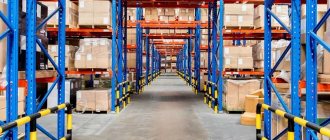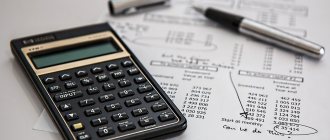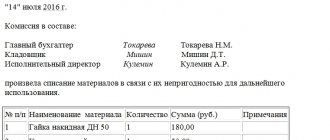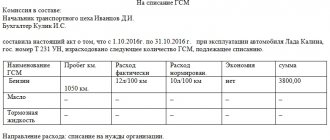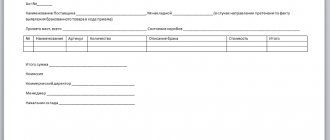Trade organizations regularly face the need to write off goods that have become unusable. First of all, these are shops and retail outlets selling perishable goods and products. However, write-off of unusable goods periodically has to be done in other areas of trade. It always starts with the inventory process. The documents drawn up based on its results are the basis for the formation of transactions and the inclusion in costs of the amounts of overdue goods in accounting and tax accounting.
Rules for writing off external and internal defects .
Legislative regulation and write-off features
During the inventory, goods that are subject to spoilage and expired are identified, as well as those on which an expiration date should be indicated, but in fact it is not. All these goods are classified as unusable and withdrawn from trade.
Write-off of goods that have become unusable is carried out on the basis of:
- Civil Code of the Russian Federation, art. 469, 470, 472;
- Federal Law-2300-1 dated 07/02/92
According to the norms of the Civil Code, the seller is obliged to offer the buyer only high-quality, usable goods. The sale of goods with an expired expiration date is prohibited, and this period must be set in such a way that the consumer can use the product before its expiration.
The Federal Law “On the Protection of Consumer Rights” requires the transfer to the buyer of goods that meet the mandatory requirements for it (Article 4), and also names goods on which the manufacturer must indicate an expiration date: medicines, household chemicals, cosmetics, perfumes, products (Article . 5).
Goods that are expired or do not have an expiration date indicated on the packaging are returned by the trading establishment to the supplier, destroyed or disposed of.
Federal Law No. 446 dated November 28, 2018 introduced a ban on the return of perishable goods of good quality (with a shelf life of less than a month). Requests for refunds or replacements for items subject to perishable deterioration have also been prohibited since the end of last year.
If the unusable product is not returned to the supplier, it is destroyed or disposed of. Without the participation of third parties, this can be done in relation to spoiled products or goods whose exact origin is unknown. In other cases, an expert assessment from a supervisory government agency (veterinary, merchandising, etc., depending on the type of product) is required.
Write-off of materials in 1C 8.3
To write off materials in the 1C 8.3 program, you need to fill out and post the “Requirement-invoice” document. The search for it has some variability, that is, it can be carried out in two ways:
- Warehouse => Requirement-invoice
- Production => Requirement-invoice
Fig.2 Request-invoice
Let's create a new document. In the document header, select the Warehouse from which we will write off materials. The “Add” button in the document creates records in its tabular part. For ease of selection, you can use the “Selection” button, which allows you to see the remaining materials in quantitative terms. In addition, pay attention to the related parameters - the “Cost Accounts” tab and the “Cost Accounts on the “Materials” tab” checkbox setting.
If the checkbox is not checked, then all items will be written off to one account, which is set on the “Cost Accounts” tab. By default, this is the account that is set in the accounting policy settings (usually 20 or 26). This indicator can be changed manually. If you need to write off materials to different accounts, then check the box, the “Accounts” tab will disappear, and on the “Materials” tab you will be able to set the necessary transactions.
Fig.3 Materials
Below is the form screen when you click the "Select" button. For ease of use, to see only those positions for which there are actual balances, make sure that the “Only balances” button is pressed. We select all the necessary positions, and with a mouse click they go to the “Selected Positions” section. Then click the “Move to Document” button.
Fig.4 Transfer to document
All selected items will be displayed in the tabular part of our document for write-off of materials. Please note that the parameter “Cost accounts on the “Materials” tab” is enabled, and from the selected items “Apple jam” is written off to the 20th account, and “Drinking water” – to the 25th.
In addition, be sure to fill out the sections “Cost division”, “Nomenclature group” and “Cost item”. The first two become available in documents if the settings are set in the system parameters “Keep cost records by department - Use several item groups”. Even if you keep records in a small organization where there is no division into item groups, enter the item “General item group” in the reference book and select it in the documents, otherwise problems may arise when closing the month. At larger enterprises, proper implementation of this analytics will allow you to quickly receive the necessary cost reports. A cost division can be a workshop, a site, a separate store, etc., for which it is necessary to collect the amount of costs.
The product group is associated with the types of products manufactured. The amount of revenue is reflected by product groups. In this case, for example, if different workshops produce the same products, one product group should be indicated. If we want to see separately the amount of revenue and the amount of costs for different types of products, for example, chocolate and caramel candies, we should establish different product groups when releasing raw materials into production. When indicating cost items, be guided at least by the tax code, i.e. you can specify the items “Material costs”, “Labor costs”, etc. This list can be expanded depending on the needs of the enterprise.
Fig.5 Indication of cost items
After specifying all the necessary parameters, click the “Pass and close” button. Now you can see the wiring.
Fig.6 Swipe and close
During further accounting, if you need to issue a similar demand invoice, you can not create the document again, but make a copy using the standard capabilities of the 1C 8.3 program.
Fig.7 1C 8.3
Our company provides support and implementation services for 1C programs, and you can also order modifications to 1C from us. If you have any questions, please contact him, we will be happy to help you.
Write-off procedure
IMPORTANT! A sample write-off act from ConsultantPlus is available here
Inventory is carried out according to rules No. 49 of 06/13/95. Damaged goods are not included in the inventory, but are entered in the write-off act according to f. TORG-16 (15) or using an independently developed form reflected in the LNA.
When using unified forms, it is recommended to fill out both acts. TORG-15 documents the fact of damage, the TORG-16 act records the withdrawal from trade circulation and further actions in relation to the goods: recycling, destruction.
On a note! When disposed of, the product can still be processed and used; if destroyed, further processing is not possible.
The destruction of goods, in addition to the act signed by the commission and the conclusion, is formalized by a separate order. If damage or impossibility of further use of the goods is detected, explanations are taken from financially responsible persons. These actions allow us to identify the reason why the product has become unusable, for example:
- expiration date missed;
- damage due to the negligence of responsible persons;
- force majeure situation.
Depending on it, transactions are reflected in tax and accounting.
“Overdue” goods and the costs of their disposal can be taken into account without any problems in the NU, when reducing the tax base. This is stated in letters of the Ministry of Finance No. 03-03-06/1/53901 dated 08/23/17, No. 03-03-06/1/30409 dated 05/26/16 and a number of others. Likewise - spoilage within the limits of loss norms. The unsuitability of the goods, as a result of the negligence of the guilty persons, is compensated by these guilty persons in accordance with Chapter. 39 Labor Code of the Russian Federation. Losses of goods are first reflected in non-operating expenses (Tax Code of the Russian Federation, Art. 265), and then as non-operating income (Tax Code of the Russian Federation, Art. 250).
How to write off inventory items due to their unsuitability or shortage ?
The situation of damage during a natural disaster makes it possible to include the cost of damaged goods in expenses (Article 265-2-6), as well as the fact of failure to identify those responsible for the damage to goods (ibid., paragraph 5). This fact must be confirmed by a certificate of termination of the criminal case (letter 16 -15/065190 dated June 25, 2009, Federal Tax Service in Moscow).
When writing off unusable goods, account 94 is used, reflecting shortages and losses of inventory items.
Write-off of building materials at the enterprise, what does the estimator have to do with it?
When constructing accounting records, the economic activities of a construction enterprise must be organized on the basis of two control systems. The first is an organizational system created to achieve the objectives of operational accounting. The second is a system of organizational procedures that controls the first system; it is built on general principles and consists of the following elements: general rules and instructions, reporting, well-thought-out accounting policies, accounting systems and accounting procedures, budget control. This entire harmonious system is aimed at creating the preconditions that the company’s goals: its economic activities and the general leadership (management) of the organization will achieve the established planned results. The performance monitoring system is an action aimed at achieving the objectives of a legal entity, which are the result of monitoring the activities of the company as a whole and also of individual structures and departments (branches and (or) separate divisions).
According to the tasks facing accounting, the organization of internal control provides sufficient confidence that, according to accounting records, it is always possible to control assets according to accounting data, namely:
- Verify the availability of enterprise assets by periodically (scheduled) checking these assets with accounting records - inventory;
- Monitor the effectiveness of use and eliminate the misappropriation of material assets.
The objects of internal control during construction are the organization’s activity cycles:
- supply cycles;
- cycles of construction and installation works (production);
- cycles for recording work results, including write-offs of inventory items.
The main task of two-stage control is to develop measures to ensure that all employees comply with their job duties . A variety of these accounting activities include the following methods:
- financial accounting (inventory and documentation, correspondence of accounts and accounting entries, reflection in monetary terms of the state of cash and its sources on a certain date);
- management accounting includes measures to assign responsible persons, standardize standards for write-off of materials and other costs;
- audits - an audit of documents, which includes checking the accuracy of document flow, checking arithmetic calculations, monitoring compliance with the rules of accounting of business transactions, inventory of material assets).
All these requirements must be implemented based on the requirements of Articles 5 - 9.19 of the Federal Law of December 6, 2011 No. 402-FZ (as amended on November 28, 2018) “On Accounting,” as well as Chapter II, which is based on the document “ Formation of accounting policies" Order of the Ministry of Finance of Russia dated October 6, 2008 No. 106n (as amended on April 28, 2017) "On approval of accounting regulations" (together with the Accounting Regulations "Accounting Policy of the Organization" (PBU 1/2008)", Regulations on accounting “Changes in estimated values” (PBU 21/2008)”) (Registered with the Ministry of Justice of Russia on October 27, 2008 No. 12522).
When performing construction and installation work (hereinafter referred to as construction and installation works), a large number of materials are used. The cost of construction and the results of economic activity of a construction enterprise greatly depend on the volume and cost of materials used. When carrying out work, the manager’s task is to organize competent accounting, on which the tax burden (base) on construction enterprises and the results of its economic activities depend.
An important role in the accounting policy of an enterprise is played by the write-off of inventory items (hereinafter referred to as inventory items) - accounting for those released into production, transferred for use for someone else's needs. At the same time, the write-off of these inventory items in construction has significant features, since the determination of the need for inventory items begins when drawing up design documentation and working documentation prepared on its basis. Design specialists or developer (operator) specialists, at the stage of making technical decisions, select one or another type of materials and equipment - goods and materials, which will be used during the construction process. For these technical solutions, based on the requirements of paragraphs 3.9 and 4.1 of MDS 81-35.2004 “Methods for determining the cost of construction products on the territory of the Russian Federation”, an estimate(s) or consolidated estimate calculation (SER) is drawn up in which the cost of future work is calculated on the basis of estimate standards.
Control of write-off of materials during construction
The General Director, together with the chief accountant, determines the accounting policy for the enterprise. According to the requirements of the legislation of the Russian Federation, specified in Federal Law No. 402 “On Accounting,” the accounting department is assigned responsibilities, in addition to the usual audit, also assigned functions for:
- preventing the write-off of materials in excess of the norm, as well as the unreasonable write-off of inventory and materials as losses;
- preventing the write-off of materials of higher quality than actually used.
These functions make it possible to identify the dishonesty of specialists performing work and save the company’s assets, thereby increasing profits.
The main issue in writing off materials is assessing their value. In accordance with the requirements of the Accounting Law, materials must be accounted for at their actual cost.
Actual cost is the sum of costs incurred when delivering material to the enterprise, which includes the following costs:
|
The need for building materials is determined by specialists from the production and technical department (PTO). Calculation of the nomenclature and volume of materials that should be used in the construction of any facility is carried out on the basis of the design and working documentation created on its basis based on the relevant regulatory and technical documents, including codes of rules (SP), technological maps, instructions for use factories producing building materials. Based on the project, a selection of materials is carried out and the material and technical supply department makes an application for the purchase of materials based on the construction schedule.
For each facility, by order of the head of the enterprise, a list of responsible employees for writing off inventory items is approved. As a rule, the head of the construction production site or a technical maintenance engineer* is appointed as the senior financially responsible person for filling out the primary documentation for the write-off of inventory items. This person is responsible for verifying the data contained in the material reports. In addition, the same order should establish the responsibility of the manager - the head of the site or the engineer of the production and technical department - for approving the processed documentation. Under their control, this work on writing off inventory items is carried out by financially responsible specialists. The control results are additionally checked by the accountant of the material table; he makes the appropriate entries in accordance with the PBU and the document flow approved at the enterprise.
*A technical equipment engineer can be an estimator.
The document flow for writing off inventory items depends on the availability of calculated and approved consumption rates for inventory items for all types of construction work. Accounting for the write-off of materials in a construction organization pursues the following goals:
- reliability of information about purchased and consumed materials;
- control over the preservation of materials according to warehouse records;
- monitoring compliance with material consumption standards during construction and installation works;
- reliable analysis of the effective use of material resources.
I would like to draw your attention once again to the fact that the statement of material consumption in construction (form M-29) is compiled by a technical and technical equipment engineer according to the design documentation. At the moment, there is an erroneous tendency that the M-29 certificate is issued by estimators on the basis of design estimates. The project estimate does not reflect the actual amount of inventory and materials; the average of material resources is based on the methodology for creating estimate standards, which determine the cost of work. Article 1, paragraphs 30 - 31 of Federal Law No. 190 “Town Planning Code” defines the estimated cost and estimated standards.
| 30) estimated cost of construction, reconstruction, major repairs, demolition of capital construction projects, work to preserve cultural heritage sites (hereinafter referred to as the estimated cost of construction) - the amount of money required for construction, reconstruction, major repairs, demolition of capital construction projects, carrying out work on the preservation of cultural heritage sites; 31) estimated standards - a set of quantitative indicators of materials, products, structures and equipment, labor costs of workers in construction, operating time of machines and mechanisms (hereinafter referred to as construction resources), established for the accepted unit of measurement, and other costs used in determining the estimated cost of construction . |
The average of the estimated cost is indicated by another, already estimated standard, so in the methodology for determining the estimated cost of construction MDS 81-35.2004, in paragraph 2.2 it is indicated:
| 2.2. The estimated norm considers the totality of resources (labor costs of construction workers, operating time of construction machines, requirements for materials, products and structures, etc.) established on the accepted meter for construction, installation or other work. The main function of estimate standards is to determine the standard amount of resources , the minimum necessary and sufficient to perform the corresponding type of work, as the basis for the subsequent transition to cost indicators. Considering that the estimated standards are developed on the basis of the principle of averaging with minimization of the consumption of all necessary resources, it should be taken into account that the standards are not adjusted towards their reduction. |
We especially draw your attention: our estimate methodology does not indicate that, on the basis of estimate standards, it is possible to generate a statement of material consumption in the form M-29. There is no such form in MDS 81-35.2004; this form was put into effect by the Instruction of the Central Statistical Office (CSO) of the USSR on November 24, 1982 No. 613 and has nothing to do with estimate standards.
The report in form No. M-29 serves as the basis for writing off materials as the cost of construction and installation work and comparing the actual consumption of building materials for completed construction and installation work with the consumption determined according to production standards .
Write-off of materials during construction and installation work is carried out on the basis of the following documents:
- certificates of completed work, form KS-2;
- accumulative sheet - a journal for recording the completion of work (according to form No. KS-6a);
- norms for the consumption of materials for a specific type of work. These standards are approved by the head of the organization;
- a report on the actual consumption of materials compared to the standard (performed monthly) according to the statement of material resources at the construction site.
It is best to compile reports on the write-off of materials using the standard M-29 form. This form is accompanied by instructions for filling out this document. This form No. M-29 by site managers and financially responsible persons to draw up a monthly report on the use of materials during construction and installation work. This document compares the actual consumption of inventory items with the costs determined by the approved standards. It is recommended that form No. M-29 be modified for a specific construction enterprise; it should consist of two sections:
- “Standard requirements for materials and volumes of work performed” (filled out by technical and technical engineers) – this can also be an estimator;
- “Comparison of the actual consumption of goods and materials with the consumption determined according to the standards” (filled out by site managers or foremen in accordance with the data in the log book of work performed. These financially responsible persons are appointed by the head of the enterprise).
The procedure for writing off materials during construction is given:
Transfer to the financially responsible person - the work producer - of a material report with the remains of inventory items in his personal warehouse (nomenclature and quantity of materials, their accounting value). Data is generated monthly at the beginning of the reporting month. Material report on form M-19*.
| 1. Formation of the M-29 report by the financially responsible person at the end of the reporting period with the determination of the balance of inventory items on a monthly basis within the time limits established by order of the head of the organization. 2. Submission of the report for verification to the production and technical department within the time limits established by order of the head of the organization. 3. Check by a specialist and approval by the head of the technical and technical department of the M-29 report and the attached material report. This report is approved by the head of the enterprise or chief engineer. 4. Transfer of these documents to the accounting department to the material desk specialist after approval by the manager or chief engineer. 5. Calculation of the cost of receipt of goods and materials, their consumption and balance (according to the documents provided). 6. Entering this data into the consolidated list of materials movement throughout the enterprise and writing it off. |
*Since 2013, the mandatory use of unified forms of primary documentation has been abolished, therefore, each organization decides whether to use this form or not on a voluntary basis. Moreover, if the decision is positive, then the requirement to use form M-19 must be written down in the company’s accounting policies.
When checking the Form M-29 report, technical equipment engineers may identify inconsistencies. In this case, the site manager (materially responsible person) is obliged to draw up an explanatory note, which indicates the reasons for the excess consumption of materials. The explanatory note must comply with the instructions attached to the M-29 report. According to the data specified in the explanatory note, an act of writing off inventory items drawn up by the commission must be drawn up. The composition of the commission is appointed by the head of the enterprise. If the overexpenditure of goods and materials occurred due to negligence, theft or damage, then the head of the enterprise must contact the competent authorities to obtain the relevant certificates. These certificates are necessary for the legal write-off of materials. If the overexpenditure of inventory and materials is recognized as justified, and it is confirmed by calculations, in this case the manager has the right to allow the accounting department to accept the cost of excessively used materials for write-off. The opposite situation may be observed - savings occurred during the reporting period, then the site manager must also draw up an explanatory note. In this situation, you always need to take into account the principle of warehouse accounting: “if there is a surplus, expect a shortage,” there is a possibility that the wrong materials were used during construction.
All construction costs are provided for in the estimate documentation, which determines its cost and, according to the contract, are not subject to change during construction, then the entire cost overrun falls on the construction contractor, since the cost of the entire construction cannot increase without inclusion in the design documentation. It follows from this that writing off materials in construction implies that the management of the construction company is obliged to take all measures to find the perpetrators and recover damages from them. It is also impossible to exclude the possibility that, for example, materials were stolen by unidentified persons or damage occurred due to a fire or natural disaster. In this case, accounting can write off inventory items, classifying expenses as non-operating .
How to set standards for writing off materials for construction and installation work
Russian accounting legislation does not establish standards by which materials for construction should be written off. Paragraph 92 of the “Methodological guidelines for accounting of industrial plants” (Order of the Ministry of Finance dated December 28, 2001 No. 119 n) states that materials are transferred for construction, literally into production, in accordance with established standards. The quantity and quality of written-off inventory items should not be uncontrolled. Norms for write-off of materials during construction must be approved by the head of the enterprise. For tax accounting, there are requirements of Article 252 of the Tax Code, specified in Part 2 of Federal Law No. 117 of 08/05/2000: justified expenses mean economically justified expenses, the assessment of which is expressed in monetary form. Documented expenses mean expenses supported by documents drawn up in accordance with the legislation of the Russian Federation, ...
Each organization develops and sets consumption standards for inventory materials independently ; they are approved by the head of the construction organization. These standards must be developed and consolidated in accordance with the requirements specified in technological maps and other similar internal documents. These documents are not developed by the accounting department, they are developed by those departments that control the construction process (PTO, including, at the direction of the manager, estimators). After their development, these standards are checked (agreed) by the chief engineer and approved by the head of the construction organization.
CONCLUSIONS:
According to current documents, the write-off of materials is carried out by specially appointed people who are professionally involved in accounting - accountants , together with financially responsible persons - the foreman or site manager.
Inventory and materials for construction are written off according to approved standards. As an exception, you can write off materials in excess of the norm. In each such case, it is necessary to identify the reason for the excess write-off. For example, technological losses or correction of defects. When eliminating a defect, the perpetrators are held liable as provided by law.
Transfer of materials in excess of the limit is carried out only with the permission of the manager, indicating the reason for the overexpenditure. The primary accounting document - the invoice - must contain a note about excess write-offs and its reasons. If the reasons are not specified, then the write-off of inventory items will be unlawful. All this will lead to distortion of the cost price, and the data of accounting and tax reporting will also be distorted.
Write-off standards are approved by the head of the enterprise on the basis of standards that can be developed by specialists from the production and technical department (PTO), including estimators. These standards can be adopted according to estimated standards or according to standards adopted in each individual enterprise. To formulate these standards, you can use construction standards, instructions for the use of materials developed by manufacturers - instructions and (or) the advisory document “Collection of standard standards for losses of material resources in construction” (addition to RDS 82-202-96) (approved by the Letter of the State Construction Committee RF dated December 3, 1997 No. VB-20-276/12)*.
*(note: This document is not in the register of estimate standards).
If a discrepancy in the consumption of materials is identified, a commission is created; a member of the commission can be a technical equipment engineer and (or) an estimator. Based on the results of the commission’s work, those responsible are held accountable in accordance with the law.
Author: Dmitry Rabotkin, Deputy Director of the Institute of Cost Engineering and Construction Quality Control, Moscow
Source: ISIIKKS / Write-off of building materials at an enterprise, what does the estimator have to do with it?
Postings
Standard transactions for damage to goods will be as follows:
- 94/41 – damaged goods written off;
- 41/42 reversal – the trade margin is reversed;
- 96, 44/94 – allocation of costs due to the created reserve for product losses or to increase sales costs (within the limits of loss norms);
- 91-2, 73/94 - attribution of costs to the perpetrators or to other expenses if the culprit is not identified;
- 73/98 – if there is a difference between the price recorded for the goods and the amount collected from the culprit;
- 98/91-1 – attribution of this difference to other income.
If the volume of damaged goods exceeds natural loss, VAT is restored: 94/68.
Unusable goods with expired expiration dates are reflected in the following entries:
- 91, 90/41 – if the product is disposed of;
- 94/41 – if the goods are destroyed.
Write-off of goods sold: postings
The fact of sale of goods, i.e. paid transfer of ownership rights to them is recorded in accounting by writing off their cost from the credit account. 41 to the debit of the sales account - which is the main one for recording sales and combining information on revenue, costs and results obtained.
The sale of goods with revenue recognition at the time of shipment is recorded using the following transactions:
| Operations | D/t | K/t |
| Sales revenue taken into account | 62 | 90/1 |
| Cost of goods sold written off | 90/2 | 41 |
| VAT is charged on the cost of goods sold | 90/3 | 68 |
| Sales-related costs written off | 90/2 | 44 |
| Payment received from buyers | 51 | 62 |
If the contract provides for the transfer of ownership of goods not upon shipment, but, for example, after payment, then the transactions formalizing the transaction will be different, and the goods will be written off not from account 41, but from the “Goods shipped” account:
| Operations | D/t | K/t |
| Goods shipped | 45 | 41 |
| VAT charged at the time of shipment | 76 | 68 |
| Receipt of payment | 51,52 | 62 |
| Sales revenue recognized | 62 | 90/1 |
| Cost of goods sold written off | 90/2 | 45 |
| Accrued VAT included | 90/3 | 76 |
| Sales-related costs written off | 90/2 | 44 |
Example
Goods worth 6,000 rubles were transferred to the sales floor as a visual sample, incl. VAT 20%. A month later, the commission declared the goods damaged and decided to write them off. The act reflects the cost excluding VAT. No persons responsible for the damage have been identified; the goods deteriorated due to natural causes.
Postings:
- Dt 94 Kt 41 - 5000 rub.;
- Dt 44 Kt 94 - 5000 rub.
Let's use the conditions of the previous example, but determine that the goods were stored in a warehouse, and as a result of the negligence of the guilty party, they became unfit for use. The guilty person, who entered into a liability agreement with the organization, confirmed in an explanatory note his agreement to compensate for the damage in full.
Postings:
- Dt 94 Kt 41 - 5000 rub.;
- Dt 73 Kt 94 - 5000 rub.;
- Dt 50 Kt 73 - 5000 rub.
Here, the cost of the goods is attributed to the guilty parties, and then the debt is repaid by depositing cash into the cash register.
Is it necessary to restore VAT, previously accepted for deduction, when writing off goods with an expired shelf life or due to shortages, theft (theft), defects, fire, etc.?
Accounting policy settings for writing off materials in 1C 8.3
In the settings, we will find the “Accounting Policy” submenu, and in it – “Method for assessing inventories”.
Fig. 1 Method for assessing MPZ
Here you should remember a number of specific features characteristic of the 1C 8.3 configuration.
- Enterprises in general mode can choose any valuation method. If you need a valuation method based on the cost of a unit of material, you should choose the FIFO method.
- For enterprises using the simplified tax system, a method such as FIFO is considered the most suitable. If the simplification is 15%, then in 1C 8.3 there will be a strict setting for writing off materials using the FIFO method, and the choice of the “Average” valuation method will not be available. This is due to the peculiarities of tax accounting under this taxation regime.
- Pay attention to the supporting information 1C, which says that only according to the average, and nothing else, the cost of materials accepted for processing is assessed (account 003).
If you still have questions about setting up your accounting policies, contact our specialists for advice on 1C programs, we will be happy to help you.
Free expert consultation
Natalia Sevorina
Consultant-analyst 1C
Thank you for your request!
A 1C specialist will contact you within 15 minutes.
Briefly for the lazy
- Unusable goods are written off on the basis of a write-off commission act as a result of the inventory of goods. The legislator equates missing the product's expiration date to the impossibility of using a product.
- Unusable commodity mass is taken into account in account 94 or in account 91/2, if its disposal is possible. In tax accounting, expired goods can be included in expenses, as well as damage within the limits of loss norms.
- If the cost of damaged goods is attributed to the perpetrators who compensated for the damage, the amount is reflected in other income and expenses. In the event of natural disasters or if the court has not determined the person at fault, damaged goods may be reflected in other expenses.
We attract a commission
According to the recommendations of experts, write-off of damaged goods or materials should be carried out after conducting an inventory with the participation of the inventory commission. It may include:
- A representative of the organization's administration (for example, a manager)
- Financially responsible person
- Sanitary inspection representative (if necessary)
Based on the commission’s conclusion, a write-off document is drawn up. The legislation does not establish the use of a unified form of the document, so it must be developed by the organization independently. The most common option is an act. You can take the TORG-15 or TORG-16 forms as a basis.
It must necessarily indicate the names of the goods, their quantity, reasons for write-off and the full names of the members of the inventory commission. The completed report can always be used as evidence of the reasons for the loss of goods from the warehouse if the inspection authorities have suspicions about the goods stored in the warehouse.
Methods for assessing materials when they are written off
An important issue in writing off materials is assessing their value. In accordance with the requirements of the Accounting Law, materials must be accounted for at their actual cost. Actual cost is the sum of costs incurred when delivering material to the enterprise, and includes:
- purchase price;
- costs associated with transportation, storage and delivery of material from the seller to the warehouse of the purchasing company;
- payment for consulting and other similar services;
- customs duty;
- payment for intermediary services.
When writing off materials put into production or upon their other disposal, the actual cost is assessed separately for each type of material (or group of materials) throughout the reporting year using one of the proposed methods:
- Estimating the cost of each unit of disposed materials. Thus, particularly valuable inventory items or non-replaceable materials are evaluated.
- Estimation of average cost. It is determined by dividing the entire cost of a group of materials being written off by the number of units.
- FIFO (First In, First Out) method. The essence of the method is that those materials that were first put on the same account are removed from the register first.
- The LIFO method is the reverse of the FIFO method, where the materials that were most recently registered are written off first.
